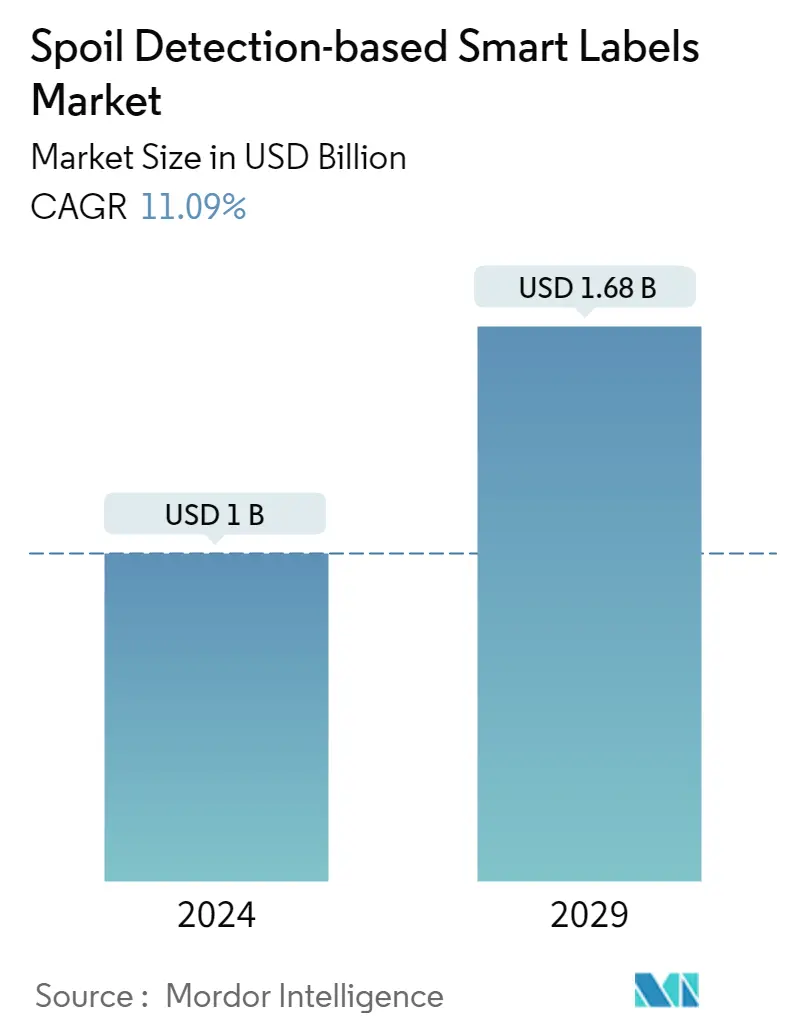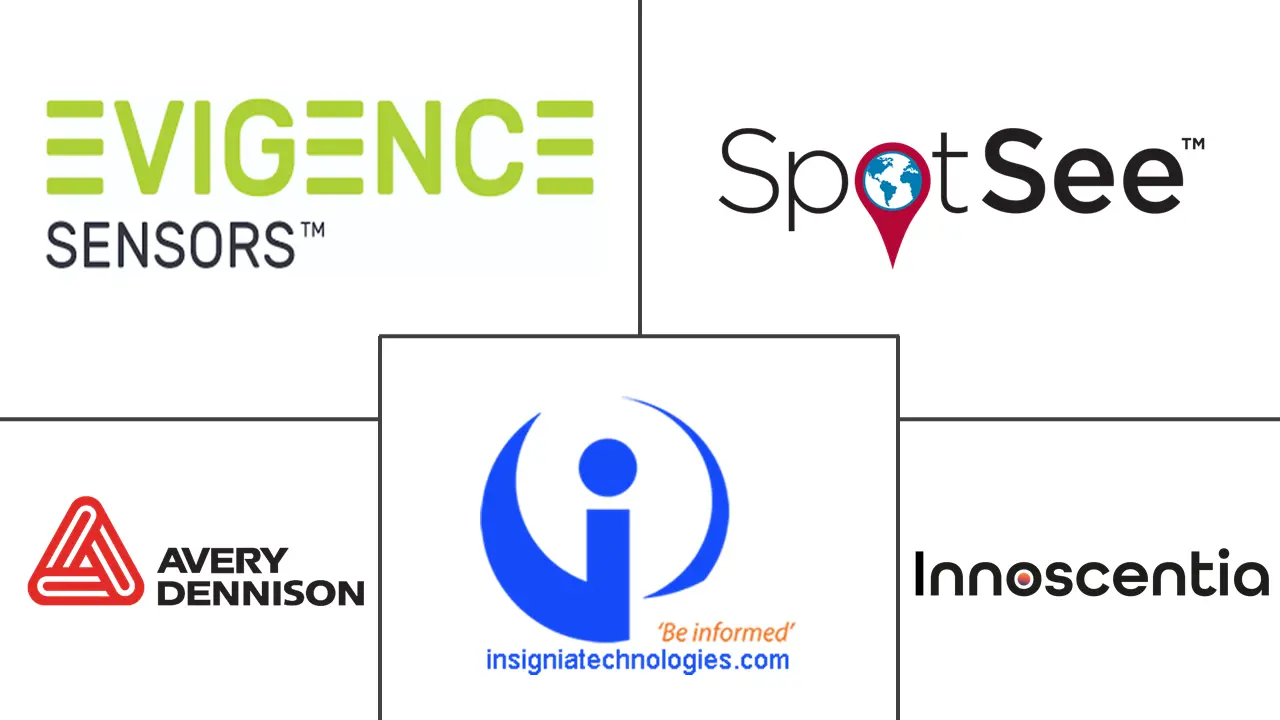Market Size of Spoil Detection-based Smart Labels Industry

| Study Period | 2019 - 2029 |
| Market Size (2024) | USD 1.00 Billion |
| Market Size (2029) | USD 1.68 Billion |
| CAGR (2024 - 2029) | 11.09 % |
| Fastest Growing Market | Asia Pacific |
| Largest Market | North America |
| Market Concentration | Low |
Major Players
*Disclaimer: Major Players sorted in no particular order |
Spoil Detection Based Smart Labels Market Analysis
The Spoil Detection-based Smart Labels Market size is estimated at USD 1 billion in 2024, and is expected to reach USD 1.68 billion by 2029, growing at a CAGR of 11.09% during the forecast period (2024-2029).
Smart labels are becoming one of the most popular technologies across the pharmaceutical, food, and cosmetics industries. They are viewed as an ideal means to achieve greater efficiencies and profitability while providing the authenticity of an item and its traceability.
- Smart labels provide detailed information about individual items in less time and offer real-time information. They also ensure authenticity and supply chain integrity while creating new opportunities for brands to engage with customers. The rising customer preference for hygienic food materials and the ability to quickly detect the degree of freshness is expected to drive the demand in the spoil detection-based smart labels market over the forecast period.
- The increased food and pharmaceutical recalls in recent years have raised global awareness about the genuine challenges of maintaining safe product temperature ranges during the production, handling, and administration of specific 'cold chain' goods. In January 2020, FUSION IV Pharmaceuticals Inc. dba. AXIA Pharmaceutical voluntarily recalled all unused sterile drug products within expiry, to the user level, due to a lack of assurance of sterility.
- Further, the emergence of the COVID-19 pandemic has led to an increase in visible behavioral changes due to a higher inclination toward safe and traceable food on e-commerce platforms and raised public consciousness about health and safety in general.
- According to an IBM study (2020), approximately 71% of consumers were willing to pay an additional average premium of around 37% for companies providing full transparency and traceability of their products. Under such conditions, end-to-end visibility within the supply chain has become one of the top priorities for businesses seeking to build trust with their consumers, where blockchain and IoT are expected to make a significant impact.
- Smart labels in the pharmaceutical, healthcare, and food industries are buoyed by the increasing need to track and maintain the quality of the products in these industries. Some smart labels are also equipped to detect spoilage, especially during transit. Many kinds of sensors are integrated into these labels, such as optical, ultrasonic, and active sensors. They are durable and provide information about moisture, temperature, movement, location, and many other factors.
- Companies deploying such sensors can use them to check the products' condition to prevent spoilage and validate their freshness. Companies may also check the temperature of storage facilities to avoid spoilage.
Spoil Detection Based Smart Labels Industry Segmentation
Spoil detection-based smart labels detect the freshness of a product and have found applications across various end-user industries. This report segments the market by technology (RFID, sensing labels, and NFC), by end-user industry (pharmaceutical, food, and cosmetics), and geography
A smart label is an item identification slip that contains more advanced technologies than conventional bar code data. Smart labels give easy and instantaneous access to detailed information about thousands of products. The most common enhancements in smart labels are QR codes, electronic article surveillance (EAS) tags, and specially configured RFID tags.
| Technology (Qualitative Trend Analysis) | |
| RFID | |
| Sensing Label | |
| NFC |
| End-user Industry | |
| Pharmaceutical | |
| Food and Beverage | |
| Logistics | |
| Cosmetics | |
| Other End-user Industries |
| Geography | ||||||
| ||||||
| ||||||
| ||||||
| Latin America | ||||||
| Middle-East and Africa |
Spoil Detection-based Smart Labels Market Size Summary
The spoil detection-based smart label market is experiencing significant growth, driven by the increasing demand for efficiency and traceability in industries such as pharmaceuticals, food, and cosmetics. These smart labels offer real-time information and ensure product authenticity, which is crucial for maintaining supply chain integrity. The rising consumer preference for hygienic and fresh food products is further propelling the market, as these labels can quickly detect spoilage and freshness levels. The market is also benefiting from the heightened awareness of food safety and quality, especially following the COVID-19 pandemic, which has led to a greater focus on traceable and safe food products. The integration of advanced technologies like RFID and IoT with smart labels is expected to enhance supply chain visibility and reduce food waste, addressing the global challenge of food insecurity.
North America, particularly the United States, is a leading market for spoil detection-based smart labels, driven by the presence of major retail chains and the need to combat food waste. The market is supported by technological advancements that allow for better prediction of food freshness and spoilage. The competitive landscape is marked by the presence of key players such as Evigence Sensors and Insignia Technologies, who are actively engaging in strategic partnerships and acquisitions to enhance their product offerings. The market is poised for substantial growth, with ongoing investments in research and development aimed at improving label technologies and expanding their applications across various sectors, including healthcare and logistics.
Spoil Detection-based Smart Labels Market Size - Table of Contents
-
1. MARKET INSIGHTS
-
1.1 Market Overview
-
1.2 Industry Attractiveness - Porter's Five Forces Analysis
-
1.2.1 Threat of New Entrants
-
1.2.2 Bargaining Power of Buyers
-
1.2.3 Bargaining Power of Suppliers
-
1.2.4 Threat of Substitute Products
-
1.2.5 Intensity of Competitive Rivalry
-
-
1.3 Industry Value Chain Analysis
-
1.4 Assessment of Impact of the COVID-19 Pandemic on the Industry
-
-
2. MARKET SEGMENTATION
-
2.1 Technology (Qualitative Trend Analysis)
-
2.1.1 RFID
-
2.1.2 Sensing Label
-
2.1.3 NFC
-
-
2.2 End-user Industry
-
2.2.1 Pharmaceutical
-
2.2.2 Food and Beverage
-
2.2.3 Logistics
-
2.2.4 Cosmetics
-
2.2.5 Other End-user Industries
-
-
2.3 Geography
-
2.3.1 North America
-
2.3.1.1 United States
-
2.3.1.2 Canada
-
-
2.3.2 Europe
-
2.3.2.1 Germany
-
2.3.2.2 United Kingdom
-
2.3.2.3 France
-
2.3.2.4 Rest of Europe
-
-
2.3.3 Asia-Pacific
-
2.3.3.1 China
-
2.3.3.2 Japan
-
2.3.3.3 India
-
2.3.3.4 Rest of Asia-Pacific
-
-
2.3.4 Latin America
-
2.3.5 Middle-East and Africa
-
-
Spoil Detection-based Smart Labels Market Size FAQs
How big is the Spoil Detection-based Smart Labels Market?
The Spoil Detection-based Smart Labels Market size is expected to reach USD 1.00 billion in 2024 and grow at a CAGR of 11.09% to reach USD 1.68 billion by 2029.
What is the current Spoil Detection-based Smart Labels Market size?
In 2024, the Spoil Detection-based Smart Labels Market size is expected to reach USD 1.00 billion.

